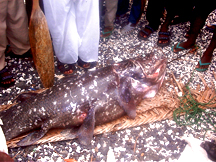More big breaking news from the oceans…
The expedition results of Jerome Hamlin, Dinofish, have been filed, and the results appear certain that a new population of coelacanth has been discovered. He was able to gather very credible testimonies on the presence of coelacanths in the archipelago of the Solomon Island, in the Western Pacific.
The findings positively indicate this new population moves the known range of coelacanths further east from Africa and Indonesia. This is exciting news, indeed, because it means that all deep-water sites similar to what is being found near the Comoros, the Sulawesi, and the Solomons may retain habitat where these 65-million-year-old “living fossils” can safely live.

Above: Dinofish’s map of known coelacanth catches and habitats with a question mark on the Solomons (move your browser to the extreme right to see the question mark).

First field-ready drawings of various fish, including a coelacanth, were shown to locals. After any matches with an illustrated coelacanth were made, this photo of a Comoros-caught coelacanth was used to confirm the Solomon Island sightings.
Jerome Hamlin details on his website the initial results of his survey. The following is his introduction; see his site for specifics on each individual testimony from his local informants at Dinofish.
Dinofish.com’s South Pacific Coelacanth Expedition
In 2006, [I,] Jerome Hamlin at dinofish.com, received a curious email claiming the existence of coelacanths in the South Pacific. Many messages like this have come in over the years, so they are all treated with a healthy skepticism. In fact there had been a claim of a coelacanth at Tahiti which was never further corroborated. There have been claims from the North Sea to the Mediterranean and from Bermuda and Florida to Puerto Rico and the Caribbean which were never verified. But there were also claims from Indonesia, Madagascar, and Kenya, which turned out to be true. This most recent claim from the South Pacific, had a terse, sparse quality to it, as if the person was completely disinterested. The location was also intriguing. For fishermen to be catching coelacanths without the whole world knowing about it, they would have to be very isolated, the area would have to have what I call “the necessary ignorance” such that the fishermen and those around them would not know that they were catching coelacanths. This had been the case in the Comoros, and again in Sulawesi, Indonesia. And now this new location seemed to fit that bill. In fact it seemed like, “The Last Place on Earth.” So the new claim had a ring of truth to it. A year later on the basis of a few lines of text, and a lot of preplanning I packed my bags, once again, for the other side of the planet.
In presenting the results of the expedition, I am withholding, for now, the specific island and village names to protect the area from potential unwanted human interference. This may change, however, if accredited research projects materialize. Suffice it to say, I am talking about the Solomon Islands, the scene of some of the most brutal campaigns of WWII. As coelacanths generally are living at depths below normal SCUBA diving operations, the research technique is to visit fish markets and the fishermen themselves in their villages. In conducting interviews with fishermen who in almost all cases don’t speak English, I use an interpreter and a picture of three fish, two of which are controls, and one of which is a coelacanth. The first control fish is a freshwater lake fish. If that fish is identified you know something is not right. The second fish is a grouper which looks something like a coelacanth and can be the same size. Varieties of grouper are common world wide and it is important for the fisherman to distinguish the grouper from a potential coelacanth. It is important to note that the pictures do not always work properly. In Madagascar, the lake fish was often identified as a tuna, and sometimes a fisherman will identify the coelacanth positively, but say that the fish he knows has different fins! One way you know things are working properly is to have some negative results, the fisherman does not know the coelacanth, but knows the grouper. This happened on the first islands I visited in the Solomons and was perversely reassuring given what happened later. I also carried an actual photograph of a coelacanth caught in the Comoros to show what one looked like having been caught and placed on the ground. No one was paid for the interviews and the Solomons do not recognize tipping as a custom. ~ Jerome Hamlin, Dinofish.
Thanks for the indicator to this from Michel Raynal.
Follow CryptoZooNews
Not Found
The resource could not be found.